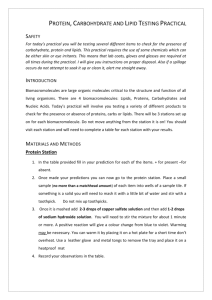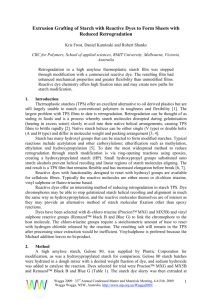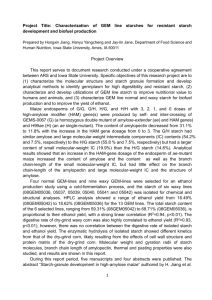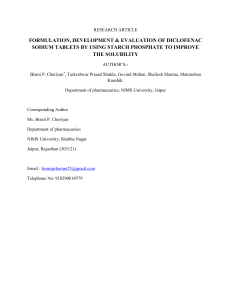Thermoplastic Starch: A Renewable, Biodegradable Bioplastic
advertisement
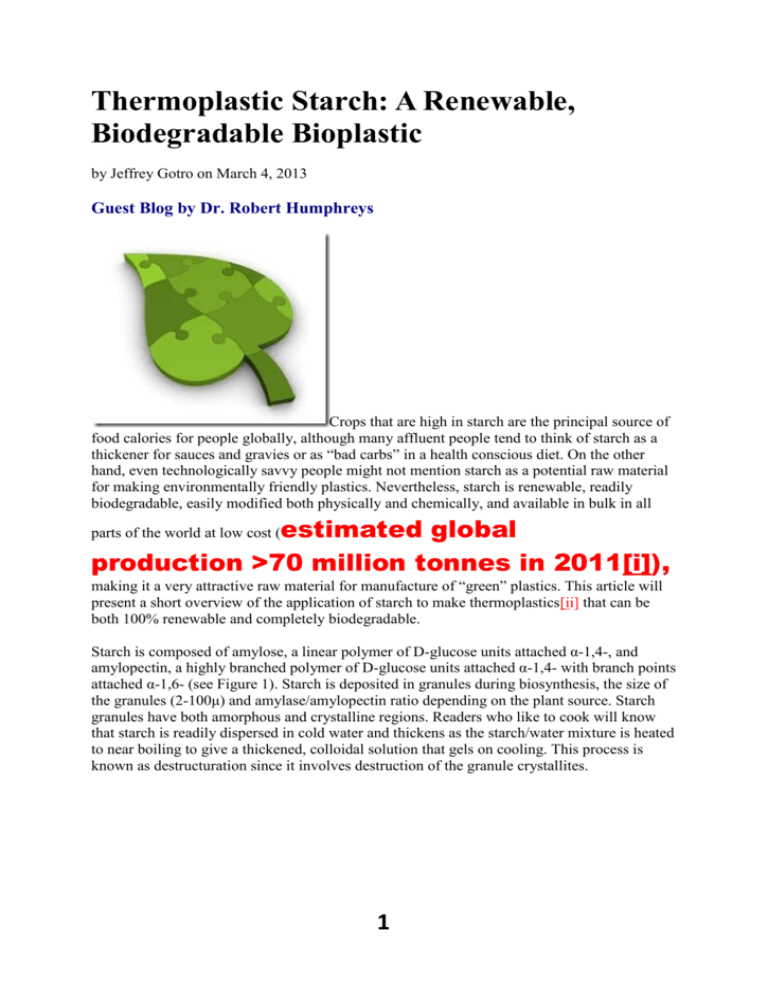
Thermoplastic Starch: A Renewable, Biodegradable Bioplastic by Jeffrey Gotro on March 4, 2013 Guest Blog by Dr. Robert Humphreys Crops that are high in starch are the principal source of food calories for people globally, although many affluent people tend to think of starch as a thickener for sauces and gravies or as “bad carbs” in a health conscious diet. On the other hand, even technologically savvy people might not mention starch as a potential raw material for making environmentally friendly plastics. Nevertheless, starch is renewable, readily biodegradable, easily modified both physically and chemically, and available in bulk in all estimated global production >70 million tonnes in 2011[i]), parts of the world at low cost ( making it a very attractive raw material for manufacture of “green” plastics. This article will present a short overview of the application of starch to make thermoplastics[ii] that can be both 100% renewable and completely biodegradable. Starch is composed of amylose, a linear polymer of D-glucose units attached α-1,4-, and amylopectin, a highly branched polymer of D-glucose units attached α-1,4- with branch points attached α-1,6- (see Figure 1). Starch is deposited in granules during biosynthesis, the size of the granules (2-100μ) and amylase/amylopectin ratio depending on the plant source. Starch granules have both amorphous and crystalline regions. Readers who like to cook will know that starch is readily dispersed in cold water and thickens as the starch/water mixture is heated to near boiling to give a thickened, colloidal solution that gels on cooling. This process is known as destructuration since it involves destruction of the granule crystallites. 1 The glass transition temperature (Tg) of pure, dry starch is probably above the decomposition point [i], so it does not soften and flow. However, starch can be plasticized (destructurized) by relatively low levels (15-30 wt %) of molecules that are capable of hydrogen bonding with the starch hydroxyl groups, such as water, glycerol and sorbitol. This “thermoplastic starch” (TPS) will flow at elevated temperature and pressure and can be extruded to give both foams and solid molded articles. Unfortunately, the properties of these simple thermoplastics tend to be disappointing. For example, TPS plasticized with water has poor dimensional stability and becomes brittle as water is lost, and the properties of water- and glycerol-plasticized TPS are poor at high humidity. TPS properties can be improved significantly by blending with other polymers, fillers, and fibers. Both natural and synthetic polymers have been used, including cellulose, zein (a protein from corn), natural rubber, polyvinyl alcohol, acrylate copolymers, polyethylene and ethylene copolymers, polyesters, and polyurethanes[ii]. Blending is usually accomplished by twin-screw extrusion at elevated temperature. Blends of TPS with other biodegradable polymers, such as polyvinyl alcohol or aliphatic polyesters like polylactic acid, polycaprolactone and poly(3-hydroxybutyrate) are fully biodegradable[iii]. For TPS blends with non-biodegradable polymers, it is likely that only the TPS component will biodegrade in a meaningful timeframe. Reinforced, 100% renewable TPS blends can be obtained by including natural fibers, such as wood pulp, hemp and other plant fibers. A number of TPS-polymer blends have been commercialized[iv]. Some examples of products made from TPS are shown in Figure 2. Applications have tended to focus on markets for which renewability and biodegradation are value-added properties. Cost reduction resulting from starch incorporation may also be a benefit. Examples of applications where biodegradation is important include: food packaging (containers, wraps); disposable eating utensils; loose fill, antistatic, and formed protective packaging; and compostable films and bags for trash, retail, and agriculture. The market size for TSP blends in the USA was estimated at 100 million pounds in 2007 with a CAGR of 19%[v]. 2 [i] “Global Modified Starch Products, Derivatives, and Markets – a Strategic Review – 2012”, S.K. Patil and Associates, http://www.marketresearch.com/S-K-Patil-and-Associatesv3203/Global-Modified-Starch-Derivatives-strategic-7083413/ [ii] Readers who are interested in more detail can refer to several recent publications, including: a) “Thermoplastic Starch, A Green Material For Various Industries”, Leon Janssen and Leszek Moscicki, editors, Wiley-VCH, Germany, 2009; b) “Lightweight, Compostable Packaging: A Literature Review”, Edward Kosior, Radek Messias Braganca, and Paul Fowler, http://www.bc.bangor.ac.uk/_includes/docs/pdf/lightweight%20compostable%20packaging.p df c) “Monomers, Polymers, and Composites from Renewable Resources”, Mohamed Nacuer Belgacem and Alessandro Gandini, editors, Elsevier, Great Britain, 2008. [iii] See reference iic, page 329, and references cited. [iv] For a more complete list of TPS blends, see reference iic, page 332. [v] See, for example, “Compostable Plastics 101. An Overview of Compostable Plastics Sponsored by the California Organics Recycling Council”, http://compostingcouncil.org/admin/wp-content/plugins/wppdfupload/pdf/8095/Compostable%20Plastics%20101%20Paper.pdf [vi] Lists of suppliers have been published. See reference iib (page 19) and iic (page 335). [vii] “Disposable Bioplastics. Consumer Disposables, Agricultural Films. A Market Opportunity Study. April 2008”, Phil Sarnacke and Stephen Wildes, http://soynewuses.org/wp-content/uploads/pdf/DisposalblePlasticsMOS.PDF. 3




